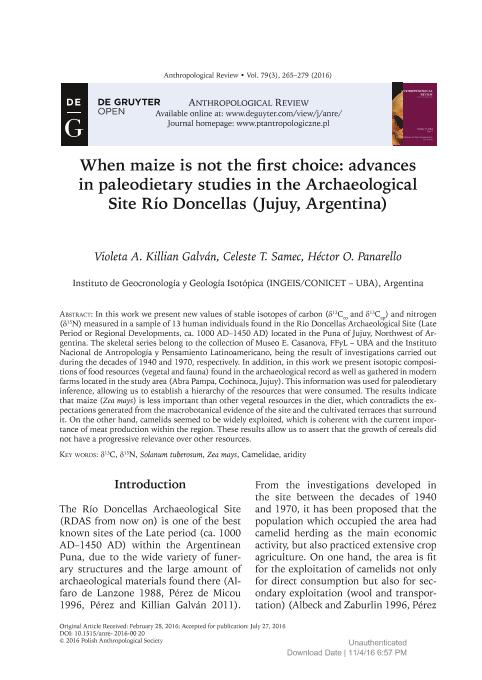Artículo
When maize is not the first choice: advances in paleodietary studies in the Archaeological Site Río Doncellas (Jujuy, Argentina)
Fecha de publicación:
01/2016
Editorial:
De Gruyter
Revista:
Anthropological Review
ISSN:
2083-4594
Idioma:
Inglés
Tipo de recurso:
Artículo publicado
Clasificación temática:
Resumen
In this work we present new values of stable isotopes of carbon (δ13Cco and δ13Cap) and nitrogen (δ15N) measured in a sample of 13 human individuals found in the Río Doncellas Archaeological Site (Late Period or Regional Developments, ca. 1000 AD-1450 AD) located in the Puna of Jujuy, Northwest of Argentina. The skeletal series belong to the collection of Museo E. Casanova, FFyL - UBA and the Instituto Nacional de Antropología y Pensamiento Latinoamericano, being the result of investigations carried out during the decades of 1940 and 1970, respectively. In addition, in this work we present isotopic compositions of food resources (vegetal and fauna) found in the archaeological record as well as gathered in modern farms located in the study area (Abra Pampa, Cochinoca, Jujuy). This information was used for paleodietary inference, allowing us to establish a hierarchy of the resources that were consumed. The results indicate that maize (Zea mays) is less important than other vegetal resources in the diet, which contradicts the expectations generated from the macrobotanical evidence of the site and the cultivated terraces that surround it. On the other hand, camelids seemed to be widely exploited, which is coherent with the current importance of meat production within the region. These results allow us to assert that the growth of cereals did not have a progressive relevance over other resources.
Palabras clave:
Aridity
,
Solanum Tuberosum
,
Carmelidae
,
Zea Mays
,
Δ13c
,
Δ15n
Archivos asociados
Licencia
Identificadores
Colecciones
Articulos(INGEIS)
Articulos de INST.DE GEOCRONOLOGIA Y GEOLOGIA ISOTOPICA (I)
Articulos de INST.DE GEOCRONOLOGIA Y GEOLOGIA ISOTOPICA (I)
Citación
Killian Galván, Violeta Anahí; Samec, Celeste Tamara; Panarello, Hector Osvaldo; When maize is not the first choice: advances in paleodietary studies in the Archaeological Site Río Doncellas (Jujuy, Argentina); De Gruyter; Anthropological Review; 79; 3; 1-2016; 265-279
Compartir
Altmétricas




